7.0 MOVEMENT PHASE
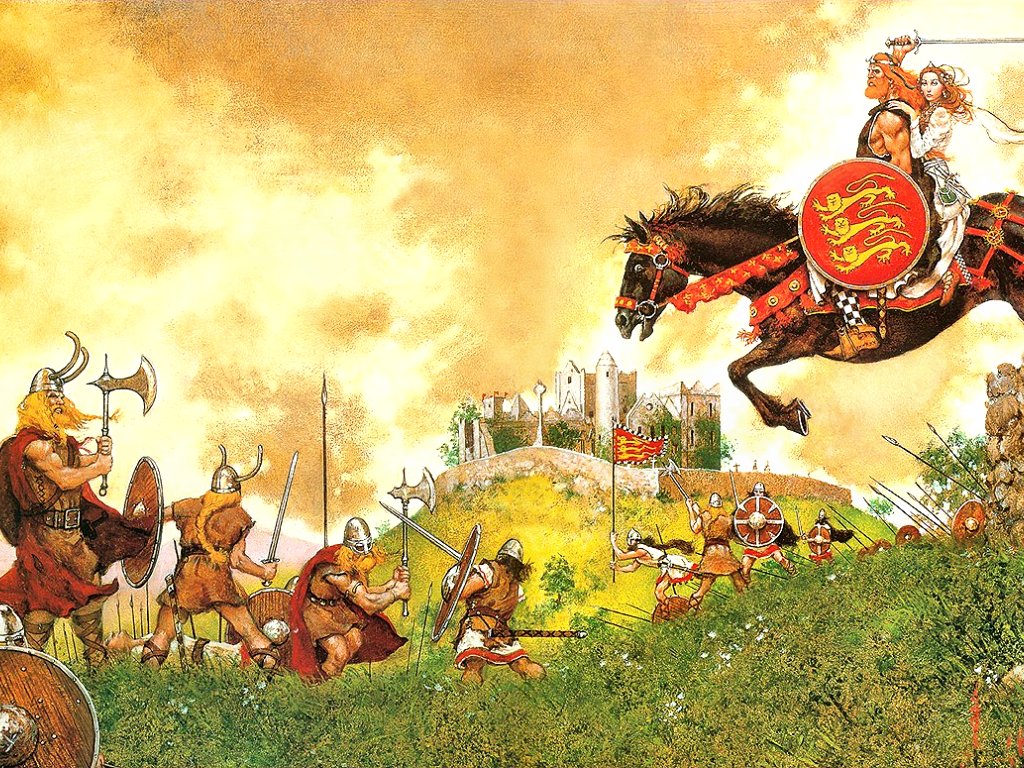
7.0 MOVEMENT PHASE

A. FORMATIONS
| 7.1 Definition of Formation | 7.2 Closed Formation | 7.3 Open Formation | 7.4 Skirmish Formation | 7.5 Mob Formation |
| 7.6 Changing Formation | - | - | - | - |
B. MOVEMENT
| 7.7 How to Move | 7.8 Movement and Enemy Units | 7.9 Changing Direction | 7.10 Changing Frontage | 7.11 Wrap-Around Movement |
| 7.12 Fighting Withdrawal | 7.13 Forced March | 7.14 Charge | 7.15 Routing | - |
| Battlesystem | - | - | - | AD&D |
Units may MOVE during the Movement Phase.
Units may also change formation,
change frontage,
change direction, and
perform other special movement.
PROCEDURE
During the Movement Phase of each
Game Round, all eligible units may
MOVE. In the AD&D game, the
movement rate for all figures is the
# of inches for that type of
creature as defined in the AD&D game.
In the D&D game, use the conversion
given in [3.1] ARMY ROSTER SHEET.
There is a movement cost for certain
terrain features (Intermediate Game
only), changes of unit formation, and
changes of direction. Figures that begin a
Movement Phase in base-to-base contact
with an enemy figure are restricted in
their movement positions.
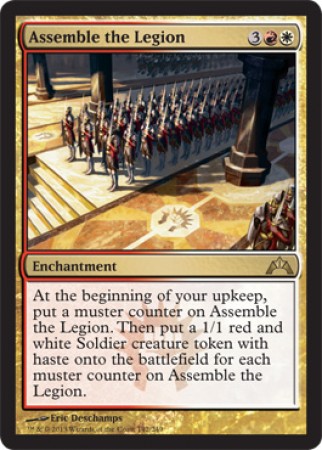
| 7.1 Definition of Formation | 7.2 Closed Formation | 7.3 Open Formation | 7.4 Skirmish Formation | 7.5 Mob Formation |
| 7.6 Changing Formation | - | - | - | - |

A formation is a deployment of troops
in a unit. There are four types of
formations:
PC/NPC individuals may o rmay not
be part of a unit. They do not have to be
part of a specific formation at any time.
Their roles are defined in [9.0] HEROES
AND COMMANDERS.

In closed formation, the figures in the
unit are in base-to-base contact.
If a unit in closed formation suffers
losses, always remove them from the rear
of the unit regardless of where they
actually occur, since the unit is assumed
to automatically fill any holes in its front
ranks.
A unit must be in command in order to enter
closed formation.
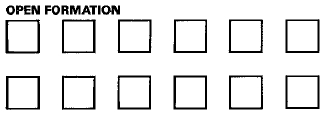
In open formation, the bases of the
figures in the unit are approx. 1/2"
apart. (OPTIONAL RULE: If you are
using stands of figures (see [2.4]
MOUNTING MINIATURE FIGURES),
place the stands 1" apart.)
If a unit in open formation suffers
losses, it must MOVE figures to fill any
gaps in its front lines. It costs 1" of
movement rate per figure that must be
moved to fill such gaps. It must pay this
cost and MOVE as many figures as
necessary to close gaps, even if it is in
base-to-base contact with an enemy unit.
If the total cost for movement exceeds
the movement rate of the unit, then the
unit fills the gap and cannot MOVE for the
remainder of the current Game Round
unless it Routs.
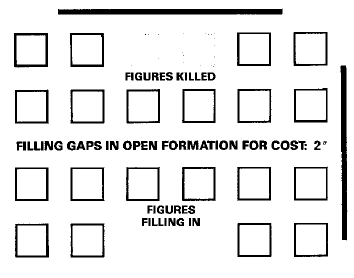
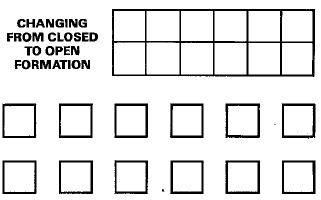
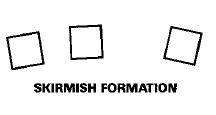
In skirmish formation, the bases of the
figures in the unit are 1" or more apart.
Figures in a skirmish unit may MOVE as
far away from each other as desired.
A unit in skirmish formation can
"pass-through" another friendly unit that
is also in skirmish formation. No other
formation can do this.
If a unit in skirmish formation loses
figures, it does not automatically fill
gaps. If it chooses, it can MOVE
individual figures at the normal
movement rate to fill gaps.
Figures operating in skirmish
formation can never MOVE into
base-to-base contact with enemy units.
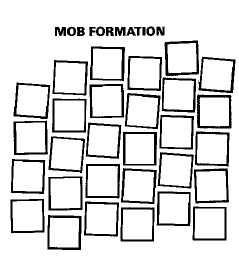
A unit in mob formation is displayed
by placing figures or units in an
irregular (but approx. square)
array. Figures in mob formation are
always placed in base-to-base contact. If
a unit in mob formation suffers
casualties, remove figures from the rear,
since a mob automatically fills in any
gaps.
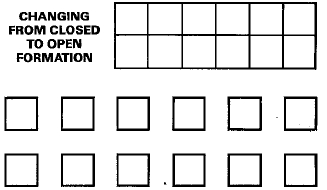
A unit may change formation at any
point during its Movement Phase. All
figures in a unit must be in command for
it to change formation, unless the unit
goes out of command or is routed. In the
latter case, it automaticaly goes to open
formation if not already in that
formation.
A change of formation costs a unit 1/4
of its movement rate. Changes of
formation that happen involuntarily
(such as going out of command or being
routed) have no cost.
| 7.7 How to Move | 7.8 Movement and Enemy Units | 7.9 Changing Direction | 7.10 Changing Frontage | 7.11 Wrap-Around Movement |
| 7.12 Fighting Withdrawal | 7.13 Forced March | 7.14 Charge | 7.15 Routing | - |
| Battlesystem | - | - | - | AD&D |
Use a ruler or tape measure to
determine hwo far a figure can move. It
speeds play if each player has his or her
own ruler or tape measure.
Measure movement from the front of
the figure's base. If an entire unit is being
moved, it is usually sufficient to measure
the move of one or two figures in
the front rank. Then MOVE the REST of the
figures in the unit and place them in the
same relation to the figures whose MOVE
you have measured as they were at the
beginning of the MOVE.
To measure the movement of a mob,
designate one figure or counter as the
point from which all measurements are
made.
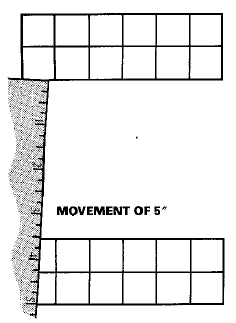
| SPECIAL NOTE: It is illegal to
pre-measure movement distances, ranges, areas of effect, or anything else without first declaring the action. Once the action is declared, those forces are committed to the stated action, or to no action for that entire phase! Q: What exactly does
the prohibition
A: Detailed descriptions
of a unit's actions
|
[7.8] MOVEMENT AND ENEMY UNITS
A figure must immed. stop its
movement when it comes into base-to-base
contact with an enemy figure. Other
figures in the same unit may continue
movement if they are not yet in
base-to-base contact with the enemy.
Figures may not change direction once any
member of the unit has made contact with
an enemy figure.
Figures that begin their Movement Phase
in base-to-base contact with an enemy
may only execute Wrap-Around
Movement ([7.11]), Fighting Withdrawal
([7.12]), or Flee ([8.8]). This
restriction
applies even if the enemy units have
moved into base-to-base contact within the
same Game Round.
A unit that has lost init and had an
enemy unit MOVE into base-to-base contact
with it cannot change formation, facing,
or frontage in its current Movement Phase.
In subsequent Movement Phases, it can
only execute Wrap-Around Movement
([7.11]), Fighting Withdrawal ([7.12]),
or
Flee ([8.8]).
Q: Rule [7.8] seems
to indicate that a
unit can perform a wrap-around
during the movement phase
even if
it does not have the initiative.
Is this
correct?
A: No. Rule [7.8]
(page 11) applies only to
units that move into base-to-base
contact
with an enemy unit during
their own
movement phase. Movement
under this
rule is not the same as
wrap-around movement
as described under rule
[7.11] (page
12). Figures in a unit moving
under rule
[7.8] may not change direction
in any way
once even a single figure
in the unit makes
base-to-base contact with
the enemy. The
figures can only move straight
ahead.
(127.66)
Units in skirmish formation can change
direction at will during their Movement
Phase without a penalty in movement rate.
Units in closed or open formation
can
move straight ahead or up to 45 degrees to
the left or right at will during their
Movement Phase without a penalty in
movement rate. Use a protractor or angle
to measure changes of direction.
Units in closed, open, or mob formation
can change direction by Wheeling. To
wheel, a unit pivots around one of its
figures. The movement cost of wheeling is
the distance moved by the outermost
figure in the unit.
Units in closed or open formation can
also change direction by Changing Facing.
There are three types of facing changes:
Right Face, Left Face, and About Face.
To make a Right or Left Face, turn all
figures in the unit (or only some figures, if
desired) 90 degrees to the right or left. The
cost of a right or left face is 1/3 of the unit's
movement rate, even if only some of the
figures changed facing.
To make an About Face, turn all figures
in the unit (or only some figures, if
desired) 180 degrees. The cost of an about
face is only 1/2 of the unit's movement rate,
even if only some of the figures changed
facing.
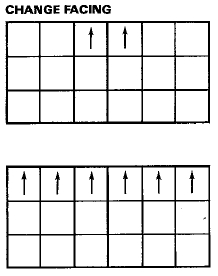
Q: The text describing
a change of
facing on page 11 does not
seem to
match the accompanying diagram.
If
the unit on the right did
a left-face,
wouldn't the relative positions
remain unchanged? The actual
result looks more like a
wheel.
A: You are correct.
A change of facing does
not alter the relative positions
of the figures
in the unit. The figure
labeled "MV
COST 1/3 MV ALLOWANCE" should
be
replaced by a unit figure
exactly like the
one to the left of it, but
with arrows pointing
off to the right.
(127.66)
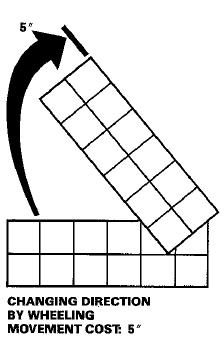
Q: The illustration
on page 11 ([7.8]) <([7.9])>
of the BATTLESYSTEM rulebook
shows a wheeling movement
and
gives the movement cost
as 5?. Can a
unit perform a double wheel
and go
twice as far, or half a
wheel and go
only half as far?
A: There is no fixed
cost for wheeling; you
have misinterpreted the
example in the
rules. A wheeling unit pivots
on one of its
"corners," the cost of the
wheel being
determined by the total
movement of the
figure that is farthest
from the pivot point.
A unit may wheel as far
as its movement
allowance allows. The 5"
cost shown on
page 11 is just an example.
(127.66)
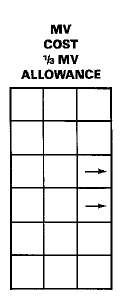

Units in closed, open, or mob formation
have a Frontage. The frontage of a unit is
the number of figures along the front side.
Units in skirmish formation do not have
frontages.
Figures may be added to or subtracted
from a unit's frontage by moving figures
up from the rear ranks of a unit or
moving them back to the rear ranks. The
movement cost of changing frontage is 1".
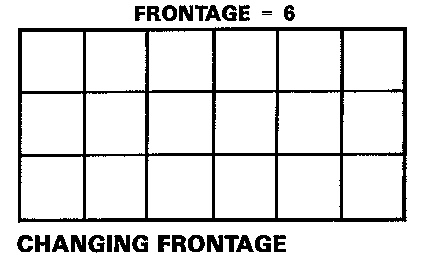
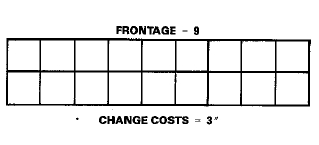
<change costs = 3"?>
A unit that begins its Movement Phase
in base-to-base contact with an enemy unit
can attempt Wrap-Around Movement
during its Movement Phase.
In wrap-around movement, the unit
expands its frontage and wheels the ends
of its battle line inward to envelop, or
wrap-around, the enemy unit. Both the
right and left flanks of a unit may wheel
inward during this maneuver.
The movement cost of wrap-around
movement is the total of the costs of
expanding frontage and wheeling the edges
of the line inward. No individual figure
may move more than its full movement
rate.
At the end of the melee, a unit that has used
wrap-around movement is automatically
considered to be in open formation. Note
that the bases of the figures will not
necessarily be 1/2" or more apart. This is
an exception to the normal rules relating to
open formation.
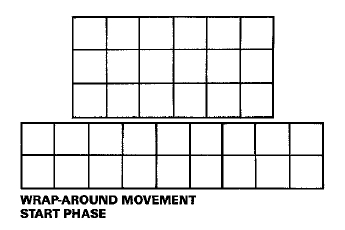
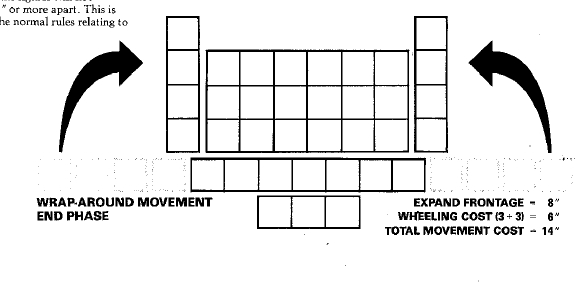
Q: Does a unit need
initiative in order
to execute a wrap-around?
A: No. In order to
execute a wrap-around, a
unit must start its movement
phase in baseto-
base contact with an enemy
unit. It must
have one or more figures
that are not yet in
base-to-base contact, and
it must have room
to expand its frontage.
Only figures that
begin the phase out of base-to-base
contact
can be involved in the wraparound.
A unit
can perform wrap-around
movement only in
its own movement phase.
For example, a
unit that is eight figures
wide and two figures
deep wins initiative and
moves into
melee with an identical
unit. In this case, the
enemy unit?s next movement
phase comes
before the melee phase,
initiative not withstanding.
The unit may use its extra
figures
to wrap the attacking unit
during this movement
phase.
(132.34)
Q: Can a unit execute
a wrap-around
if attacked from the rear?
A: No.
(132.34)
A unit that is in base-to-base contact
with an enemy unit at the beginning of its
Movement Phase can attempt to make a
Fighting Withdrawal. The unit attempting
to make a fighting withdrawal must have a
current movement rate of at least 3".
To make a Fighting Withdrawal, the unit
moves 3" backward, away from the enemy
unit. It may not end up in base-to-base
contact with another enemy unit.
The enemy unit has the immed.
option to either remain in place, or to
advance 3" and remain in base-to-base
contact with its opponent. It may do so
even if it has already used its full
movement rate during that Game Round.
If the enemy unit consists of creatures
with low INT or chaotic alignment,
it must make a Discipline Check.
If the check succeeds, the unit has
the option to remain in place; otherwise,
it automatically advances to continue the
melee.
If an enemy unit elects to remain in
place, it cannot Charge the unit that
withdrew for the remainder of the current
Game Round.
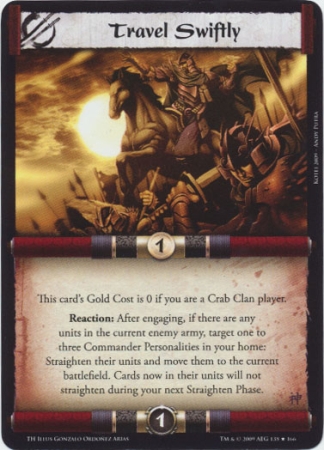
A unit or individual can MOVE farther
than its full movement rate through a Forced March.
A unit must be in command to
make a
forced march. PC/NPC individuals can
always make a forced march. A unit
cannot be in base-to-base contact with an
enemy figure during any part of its
Movement Phase during a Game Round in
which it makes a forced march.
A unit that makes a forced march must
make a Morale Check at the end of its
MOVE. If the check is failed, the unit's
Attack Rating (AR) worsens by one (e.g.,
19 becomes 20; 16 becomes 17). This
penalty accumulates. (Units that "never
check morale" are subject to this penalty.)
EXAMPLE: A unit with an Attack
Rating of 15 makes a forced march for
three Game Rounds. At the end of the first
Game Round, it fails a Morale Check, and
the AR goes to 16. At the end of the
second Game Round, it fails its check
again, and the AR becomes 17. At the end
of the third Game Round, it makes a
successful Morale Check, so the AR
remains 17.
This AR penalty stays until removed.
The AR improves by one (up to its original
value) each time the unit spends one entire
Game Round doing absolutely nothing and
is not attacked.
A unit that makes a Forced March
moves 1 1/2 of its normal full movement
rate.
Q: What happens when
a unit on a
forced march comes into
contact
with an enemy unit? The
rules seem
to indicate that something
terrible is
supposed to happen.
A: A unit cannot execute
a forced march if
the forced march will bring
it into contact
with an enemy unit. How
this restriction
works out in practice depends
on the
situation. For example,
a unit with a movement
rate of 12" can make a forced
march
of up to 18". The unit cannot
use a forced
march to make melee contact
with an
enemy unit that is more
than 12" worth of
movement away. If the unit
makes a
forced march and comes into
contact with
an enemy unit before it
has exceeded its
normal 12" movement rate,
it loses its 6"
forced march bonus as it
must follow rule
[7.8] on page 11; the unit
suffers no other
penalties. If a unit making
a forced march
can see an opposing unit
that lies just
beyond the marching unit's
normal movement
limit, the marching unit
comes to a
halt at the limit of its
normal movement
rate (the troops are assumed
to have
stopped to catch their breath
before
melee). However, if the
unit accidentally
runs into a hidden or invisible
unit after it
has exceeded its 12" movement,
it is
stopped and ambushed by
the hidden
force. In the melee phase,
the hidden
force gains the initiative
and inflicts damage
on the moving unit before
the moving
unit can return the attack.
(127.66)

A regular unit || mob may
Charge
during its Movement Phase if it can reach
an enemy unit to engage in melee at the
end of its move. A charging unit may
move 1 1/2 its normal movement rate (this
is called a "charge range"). At the end of
the MOVE, the charging unit must be in
base-to-base contact with an enemy unit or
figure, and it must attack that figure
during the Melee Phase.
Skirmish units and individuals cannot
charge. Their "charge range" for Discipline
Checks is the same as their normal
movement rate.
To charge, the unit must be able to MOVE
at least 2/3 its normal movement rate
before it comes into base-to-base contact
with its TARGET. The 2/3 of the charge
distance must be in a straight line.
A unit may charge in open, closed, or
mob formation. A regular unit that
charges in closed formation gains a -1
bonus (minuses are advantageous) to its
Attack Rating [8.3] for the Melee Phase
in that Game Round only.
If the charging unit is in closed
formation and consists of creatures of
chaotic alignment or low intelligence, it
must make a Discipline Check when
charging. If the Discipline Check fails,
the unit goes out of command and breaks
into open formation during the charge.
Except in this one instance, an out of
command regular unit cannot charge.
If the charging unit runs into an enemy
figure or figures that would be killed
even if the charging unit does min.
possible damage, it Breaks Through. The
enemy figures are immed. removed
and the unit continues its charge. The
charging unit does not need to eliminate
an entire unit to break through; just
those figures in its path. However, the
charging unit must end its Melee Phase in
base-to-base contact with another enemy
figure or figures or suffer the penalty
below.
If a unit in closed formation fails to
end its charge in base-to-base contact
with an enemy figure or figures, it breaks
into open formation, but remains in
command. If a unit in open or mob
formation fails to end its charge in
baes-to-base contact with an enemy
figure or figures, it suffers a -3 penalty to
current morale for the remainder of the
current Game Round.
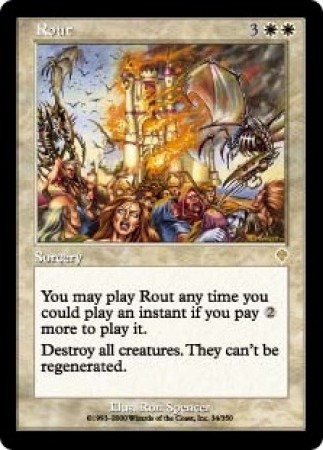
If a unit in open or skirmish formation
fails a Morale Check, it Routs. Place a
Rout marker on any unit that routs.
A routing unit immediately moves
away from the enemy a total of its
movement rate plus an additional 1/3 of
its movement rate, and ends its move
with its back to the
enemy. A unit always routs away from
whatever caused the Morale Check, and
routs toward its own lines if psb..
If a routing unit hits a friendly unit that
has not routed, the unit that has not
routed must make an immed. Morale
Check. If that unit routs, it moves ahead
of the friendly unit that forced the Morale
Check. If the checking unit does not rout,
the routing unit "breaks around" the
checking unit, reforms on the other side,
and continues its movement. (Note that a
routing unit can pass-through a unit in
skirmish formation--but the unit in
skirmish formation must nevertheless
make a Morale Check.)
The owning player may attempt to rally
units that have routed during the Rally
Phase (see [6.0] RALLY PHASE). If no
attempt to rally is made, or if an attempt
to rally fails, the routing unit continues to
rout. On the Movement Phase that
follows, the routing unit moves its full
movement rate in the same direction it was
moving.
If a routing unit moves off the edge of
the table, or across the edge of the
battlefield, it is removed from play.
If a unit that would otherwise rout is
completely surrounded (all passable terrain
completely blocked) by an enemy unit in
closed or open formation, and there is no
gap of 1" or more of passable terrain
through which even a single figure could
escape, the routing unit is automatically
destroyed and removed from play.
Otherwise, the entire unit is entitled to
rout through the gap. When escaping
through such a gap, no single figure in the
routing unit can MOVE more than its rout
movement rate.
OPTIONAL RULE: In a campaign
battle, if a unit completely surrounds a
unit that would otherwise rout, the
attacking player can choose to Capture the
routing unit. The attacking player
designates one of his figures as Guards for
every four captured enemy figures;
otherwise, the enemy figures automatically
escape. Escaped figures are treated as
Routed figures for all purposes. The
attacking player receives twice the normal
number of XP for captured
figures at the end of the game (see [16.2]
EXPERIENCE POINTS), and may be able
to ransom them if the campaign situation
permits. Captured prisoners can also be
traded for prisoners held by the other side,
if the trading players agree.
Q: Where exactly will
routing units
go if there are enemy units
between
them and their own lines?
Do they
run toward their heroes
or commanders?
What happens if a routing
unit encounters an impassable
terrain
feature such as a river?
A: Routing units move
away from the cause
of the rout along the path
of least resistance.
They go toward the point
at which
they entered the playing
area, avoiding
obstacles and enemy units
along the way.
When a routing unit encounters
terrain
that it cannot cross or
enter, it moves
along the edge of the feature
in the direction
that takes it away from
the enemy.
(127.14)
Q: What happens when
a unit that
has performed a wrap-around
suffers
a rout? Do the figures scatter?
Or does the unit pay movement
cost
to "unwrap," then rout directly
away
from the enemy?
A: Generally, the
whole unit routs in the
same direction. It doesn't
have to
"unwrap" because it does
not change
formation. The main body
of the unit
routs directly away from
the enemy, and
the figures on the flanks
follow.
(127.14)
Q: Is there any way
to stop a routing
unit other than rallying
it?
A: No, a unit continues
to rout until it rallys
or leaves the board.
(127.14)
Q: Do routing units
have to pay a
movement penalty for the
aboutface
required to turn their backs
to
the enemy? Do they pay terrain
costs when they move through
woods or up hills?
A: Routing units do
not pay for the change
of facing. They ignore terrain
modifiers as
long as the terrain is passable.
(127.14)
Q: If a routing unit's
path takes it past
several commanders or heroes,
can
each commander attempt to
rally
the unit?
A: There may be only
one attempt to rally a
unit per rally phase, the
number of commanders
present notwithstanding.
(127.14)
General note on routs:
There are so
many variables affecting
the actions of a
routing unit that it is
impossible to cover
every possible situation.
Players and referees
must apply some common sense
when adjudicating routs;
just remember
that a routing unit wants
to get away from
whatever caused it to rout,
and will try to
exit the battlefield at
the same point that it
entered.
(127.14)
![]()
Reduce - Reuse - Recycle